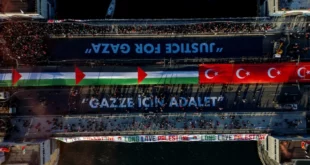
Despite losing its caliphate and its leader, recent attacks show the militant group has begun to recover amid international disunity.
Over the last two months, Islamic State has carried out a series of large-scale and coordinated attacks in parts of Syria and Iraq. The spike in attacks has renewed fears about the group’s resurgence, a year after the collapse of its physical caliphate in eastern Syria and only six months after the killing of its former leader, Abu Bakr al-Baghdadi. The heightened activity is especially worrying because the conditions that have made it possible appear set to worsen in the coming months.
Isis has never ceased attacks in the two countries since the loss of its territories, but the recent operations are particularly bad news. Aside from the attacks, for example, reports from the ground consistently suggest that the group has had greater visibility and mobility this year in villages and suburbs across Iraq and Syria.
The way in which some of the attacks were conducted also indicates that the group has access to information about troop movements and individuals it seeks to target. Such trends are usually early signs that the group has established roots, carved out space for itself and built the infrastructure necessary to launch attacks.
This recovery is recent, and follows at least a year of weakness in both countries, due to the loss of Isis centres in Mosul and Raqqa and the intense military campaigns against it. This weakness reached its lowest point with the killing of Baghdadi in October. The group seemed unable to carry out revenge attacks for the killing of its self-proclaimed caliph, or to exploit significant openings such as the US announcement that it was withdrawing its troops from Syria, which was followed by Turkey’s invasion of parts of the north.
Warnings that such events would open the door for the group to re-emerge did not transpire. Several months later, though, the group rebuilt its capabilities and became more active – the most active since the collapse of its caliphate. This time lag between decreased pressure and the ability to rebound matters because it reveals precisely how Isis could be put back in its box.
It took Isis some time to regenerate because the sustained military pressure against it had prevented it from quickly seizing clear openings such as the chaos that followed the American withdrawal – which was later reversed – and the Turkish invasion. The pressure had been building steadily against Isis since the recapture of Mosul in 2017 and Raqqa in 2018, and the US-led forces largely focused on clearing operations in abandoned villages, mountains and deserts to ensure a more enduring defeat of the organisation. It would have been hard to contain the organisation had it been “ready” to attack when such opportunities presented themselves in October.
The steady pressure was disrupted by a chain of events in both countries, paving the way for Isis to return. The initial US withdrawal from Syria caused its allies on the ground, the Kurdish-dominated forces, to seek the help of Russia and the regime in Damascus to prevent Turkey from taking over. Even after the US reversed its decision to withdraw, part of the third of Syria previously controlled by the international coalition became shared with the Russians. The damage was already done, as the international mandate against Isis shrank in both territory and influence.
In Iraq, too, mass protests in Iraq in October triggered several events and raised the political temperature in the country. The protests in central and southern Iraq forced the government to resign and led to political stagnation that lasted until two weeks ago, when political parties agreed on a new prime minister, Mustafa al-Kadhimi.
The protests, which sometimes included an anti-Iran tone, also added to the tensions between the US and Shia forces in the country. Attacks and counter-attacks, by the US and Iranian proxies, ultimately led to the killing of the Iranian general Qassem Suleimani and the prominent Shia militia leader Abu Mahdi al-Muhandis.
Despite what seemed like a perfect storm, Isis could not expand its influence until recently. The earliest notable attack happened on 9 April, between the group and Syrian regime forces near Palmyra in the Syrian desert. The attack appeared sophisticated, as the group ambushed regime forces and clashed with them for several hours. Later that month, Isis conducted several attacks in Kirkuk, Diyala and Salah ad-Din. Such attacks included the attempted storming of the counter-terrorism and intelligence directorate in Kirkuk, and several coordinated attacks in Salah ad-Din. The attacks were among the most sophisticated in years.
Isis clearly benefited from the security vacuum and decreased pressure in both countries. As Isis establishes a foothold, it soon becomes hard to weaken it without deeper international engagement. Renewed tactical operations might force it underground but it will not dismantle its networks, because that process requires a patient counter-terrorism strategy that seemed to exist a year ago.
The recovery of Isis is still new and fragile, and so could be easily reversed if the pressure is restored. However, the problem is that the current trends seem more favourable to Isis than to local forces. Tensions between the US and Iraqi forces also make it harder for the two partners to work in harmony as they did during the fight against Isis in places like Mosul. The US has already withdrawn from several tactical bases in western and central Iraq, in the very areas in which it recently carried out attacks.
In other words, the chances for further Isis recovery are increasing as the odds decrease for a tougher crackdown led by the US. This pattern is what makes the current phase particularly dangerous. If the pattern continues in the coming months, Isis is likely to become a far greater threat that will be much harder to contain than it is now.
 Eurasia Press & News
Eurasia Press & News


